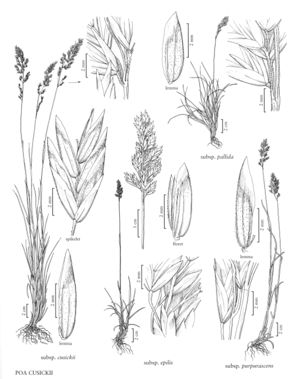Poa cusickii subsp. pallida
Plants densely tufted. Basal branching intravaginal. Culms 10-40 (55) cm, mostly erect, with 0 (1) scarcely exserted nodes. Sheaths closed for 1/4-2/3 their length, distal sheath lengths 3.6-10 times blade lengths; innovation blades 0.5-1 mm wide, apices usually narrowly prow-shaped; cauline blades usually less than 1.5 mm wide, flat, folded, or involute, usually narrowly prow-shaped, infrequently broadly prow-shaped, flag leaf-blades 0.5-2 (3) cm. Panicles 2-6 cm, contracted, with 10-40 spikelets; nodes with 1-3 branches; branches 0.5-1.7 cm, stout, moderately to densely scabrous, with 2-5 spikelets. Spikelets 4-10 mm. Calluses glabrous; lemmas 4-7 mm, glabrous; anthers vestigial (0.1-0.2 mm) or 2-3.5 mm. 2n = 56, 56+11, 59.
Discussion
Poa cusickii subsp. pallida grows in forb-rich mountain grasslands to alpine habitats, from the southern Yukon Territory to California, across the Great Basin and through the Rocky Mountains to central Colorado. It is found mainly east and north of subsp. cusickii, but pistillate plants extend into the range of that subspecies in the eastern alpine peaks of California, Nevada, and Oregon. The shorter branch length serves to distinguish it from the narrow-panicled subsp. cusickii forms in most cases. It hybridizes with P. fendleriana (p. 556), forming P. xnematophylla (see next). The hybrids may have hairy lemmas or, less often, broader leaf blades and glabrous lemmas. Poa cusickii subsp. pallida was included in Hitchock's (1951) circumscription of Poa pringlei, along with P. keckii and P. suksdorfii.
Selected References
None.
Lower Taxa
"reduced" is not a number.No values specified."decumbent" is not a number.
